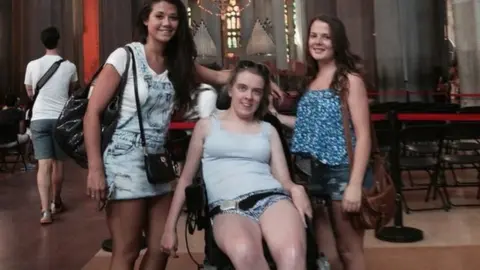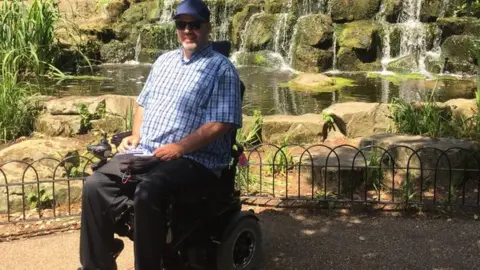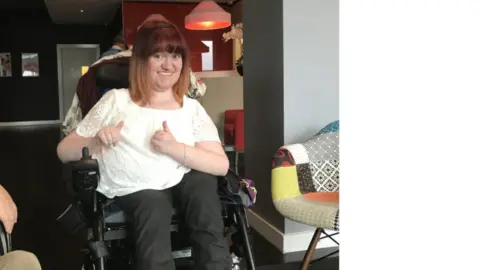'Airlines keep breaking my wheelchair'
 Francesca Pardoe-Lamb
Francesca Pardoe-LambThe stress of air travel has increased this summer, with long queues reported across Europe because of tighter security and immigration checks.
But for one group of passengers - those who use wheelchairs - flying often turns into an upsetting and nerve-wracking experience, whatever the time of year.
From problems getting on the plane, to difficulties checking in equipment, and even being unable to go to the toilet onboard, there is always something to worry about.
But there is one issue that can really ruin a holiday: damage to the wheelchairs which are our mobility lifelines.
My wheelchair has been damaged multiple times, including on a recent EasyJet flight to Portugal at the end of July. So I set out to uncover the scale of the problem.
Special travel wheelchair bent
I use a powerchair to get around; my cerebral palsy means my arms are too weak to propel a manual wheelchair. The chair is custom-built, heavy and extremely expensive.
When I fly, my chair goes in the hold. On two successive trips in 2013, to Dublin and Barcelona, it came off the flight home making a foreboding rattling sound.
A few weeks later, it stopped working. The repairs were costly and left me stuck in my university room, entirely reliant on others.
If I was going to continue travelling, I needed another plan.
I thought I'd solved the problem when I invested in another chair, which is specifically designed for travelling by air. The expensive piece of kit consists of a manual chair and an attachable motor.
When flying, the motor can be stored in a suitcase. The idea is that breakable parts are kept safe.
And yet, when I came to reassemble my chair after I arrived in Portugal last week, the motor had been bent out of shape. Five of my friends could not reattach it to the manual frame.
(EasyJet says it is "very rare" for its ground handling companies to damage wheelchairs. When it does happen, they say, they arrange for repairs and a replacement chair. The airline also points out its customer satisfaction amongst passengers with reduced mobility was 84% in 2016).
I spent the whole holiday in Portugal unable to move independently more than a few metres. And it turns out that my experience is far from unique.
 Dan Dorszynski
Dan DorszynskiAfter flying more than 40,000 miles all over the world this year, Dan Dorszynski's wheelchair was broken on a short flight from Philadelphia to Detroit.
"The cargo guys couldn't fit it into the cargo door so they crammed it in and broke the backrest, armrest, and a few other things on my chair," he says.
Although his chair was "drive-able", Dorszynski says it couldn't be fixed in time for his next trip. He bought a used version of the same model to take instead.
"Upon leaving Sweden on the way to return home, the airline insisted that I check this chair at the ticket counter instead of taking it to the gate because it was too heavy.
"I argued a bit... however it was fruitless and I just decided to let them have it so it would not be an issue.
"I get to Chicago and after all that, my back-up chair never made it on the first flight. Here I am two days later wondering where that chair is."
 Michaela Hollywood
Michaela HollywoodMichaela Hollywood has also had difficulties when flying.
"Pretty much every time I've flown before [her most recent flight] there have been problems," she says.
"My chair has been lost for two weeks, only half of it brought back; stuck on the plane, stuck on the ground... my dad once had to actually put it into the hold himself."
And Jeff Courtade was left "bedbound" in his house for "nearly a month" after a flight from San Francisco to Washington DC.
His highly-customised and pain-relieving chair was bent and rendered immobile.
"I am terrified of flying now," he says.
'A cultural problem'
In my opinion, the problem has three parts:
- How airports and airlines handle wheelchairs
- How they compensate passengers for the cost of repairs
- The difficulty getting a temporary replacement chair in order to carry on with holidays or everyday life
In the eyes of the industry, it seems, a wheelchair is the same - and as robust - as any other piece of luggage.
I have seen my own motor being flung into a trolley of suitcases. Others have found their powerchairs lying on their sides on conveyor belts.
Staff often do not know what they are handling - moving specially-positioned backrests and unplugging vital parts of chairs which cannot just be reattached.
Chairs get lifted and pushed in ways that damage them. My powerchair's brakes were destroyed when staff pushed it without following instructions to set it to its manual settings.
All wheelchairs are different, but some basic training in how they usually work would go a long way.
Once a wheelchair is damaged, it is difficult and expensive to get it fixed. Transporting a broken powerchair involves specific vehicles and a lot of strength (they regularly weigh over 100kg).
Spare parts, particularly for customised chairs, can take weeks to arrive and cost hundreds of pounds. A new chair could cost thousands.
Being awarded compensation for these costs is also an uphill struggle.
"The issue is cultural rather than operational," says Roberto Castiglioni, who set up the organisation Reduced Mobility Rights after experiencing the challenges of travelling with his disabled son.
He now helps others to make successful compensation claims for damage or mistreatment.
Thanks to the division of responsibilities between airports and airlines, there is "endless (and useless) finger-pointing when something goes horribly wrong," he says.
As for me, I eventually made it home from Portugal to the comfort and ease of my powerchair. I'll be setting off on my holidays again next year - perturbed but thankfully not deterred.
But many will find themselves unwilling to entrust their most important belongings to an industry which - all too often - seems not to recognise their value.
What can wheelchair users do?
- Remove detachable parts such as head and arms rests, footplates and joysticks and carry them onboard
- Submit a Special Declaration of Interest before flying, allowing compensation claims above the usual cap to be made
- Label chairs with instructions on how to move them and which parts cannot be detached
- Pack detachable motors in sealed, hard cases
